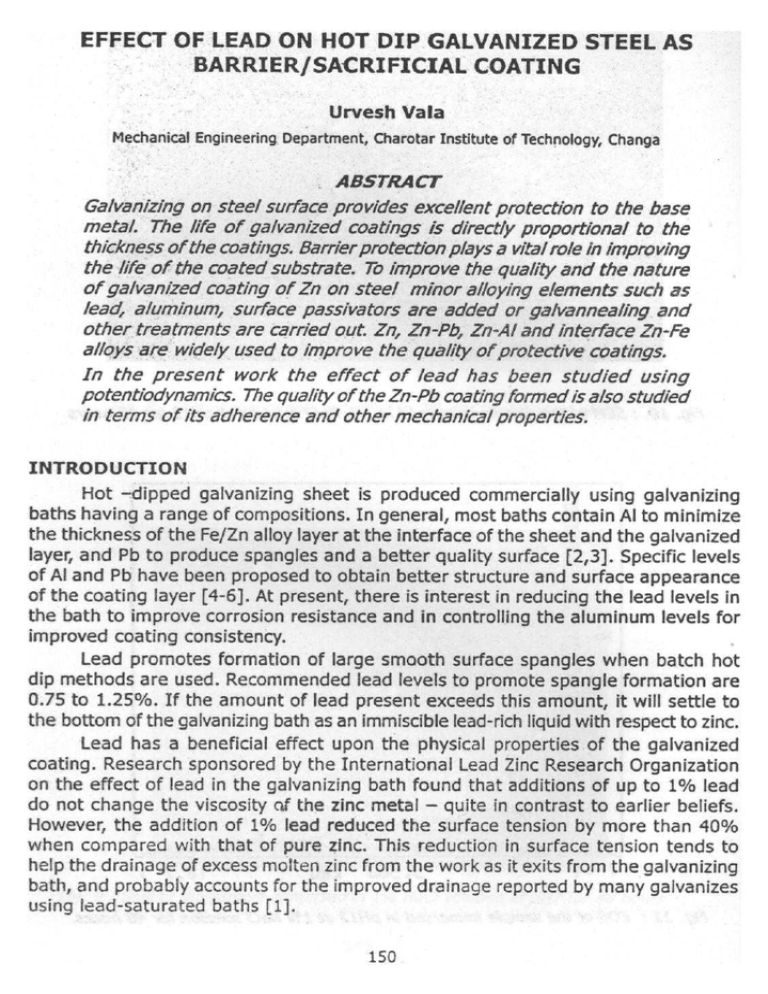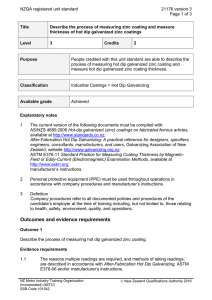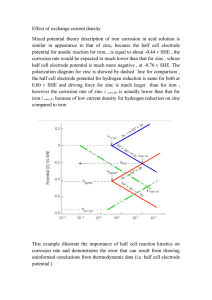effect of lead on hot dip galvanized steel as barrier
advertisement

EFFECT OF LEAD ON HOT DIP GALVANIZED STEEL AS BARRIER/ SACRIFICIAL COATING Urvesh Vala Mechanical Engineering Department , Charotar Institute of Technology, Changa ABSTRACT Galvanizing on steel surface provides excellent protection to the base metal. The life of galvanized coatings is directly proportional to the thickness of the coatings. Barrier protection plays a vita/ role in Improving the life of the coated substrate. To improve the quality and the nature of galvanized coating of Zn on steel minor alloying elements such as lead, aluminum, surface passivators are added or galvannealing and other treatments are carried out. Zn, Zn-Pb, Zn-Al and interface Zn-Fe alloys are widely used to improve the quality of protective coatings. In the present work the effect of lead has been studied using potentiodynamics. The quality of the Zn-Pb coating formed is also studied in terms of its adherence and other mechanical properties. INTRODUCTION Hot -dipped galvanizing sheet is produced commercially using galvanizing baths having a range of compositions. In general , most baths contain Al to minimize the thickness of the Fe/Zn alloy layer at the interface of the sheet and the galvanized layer, and Pb to produce spangles and a better quality surface [2,3]. Specific levels of Al and Pb have been proposed to obtain better structure and surface appearance of the coating layer [4-6]. At present, there is interest in reducing the lead levels in the bath to improve corrosion resistance and in controlling the aluminum levels for improved coating consistency. Lead promotes formation of large smooth surface spangles when batch hot dip methods are used. Recommended lead levels to promote spangle formation are 0.75 to 1.25%. If the amount of lead present exceeds this amount, it will settle to the bottom of the galvanizing bath as an immiscible lead-rich liquid with respect to zinc. Lead has a beneficial effect upon the physical properties of the galvanized coating. Research sponsored by the International Lead Zinc Research Organization on the effect of lead in the galvanizing bath found that additions of up to 1% lead do not change the viscosity of the zinc metal - quite in contrast to earlier beliefs. However, the addition of 1% lead reduced the surface tension by more than 40% when compared with that of pure zinc. This reduction in surface tension tends to help the drainage of excess molten zinc from the work as it exits from the galvanizing bath, and probably accounts for the improved drainage reported by many galvanizes using lead-saturated baths [1]. 150 However very little literature is available regarding the corrosion / anodic dissolution behavior of galvanized steel with Pb addition . In the present paper an attempt has been made to study the effect of Pb addition on hot dip galvanizing using polarization techniques. EXPERIMENTAL WORK In this work Hot dip steel plates with 0.5%, 1.0%, 1.5%, 2.0 %, & 2.5% lead and without alloying addition were studied using polarization techniques in 0.5% and 3 . 5% NaCl solutions and compared their corrosion and anodic dissolution behavior. These tests were carried out using Potentiostat / Galvanostate Model 273 corrosion measurement system supplied by EG & G Princeton applied research, U.S.A. The size of sample exposed was 2 c.m. X 3 c . m. Experiments were conducted using the standard three electrode configuration , saturated calomel as a reference electrode with a graphite rod as a counter electrode and the sample as a working electrode. Specimens were immersed in the test solution with the help of specimen holder ( 12 cm2 exposed area ). The quality and nature of passivation film was evaluated using A . C. Impedance techniques with the help of 5210 Lock in Amplifier system and M398 software supplied by EG & G Princeton applied research, USA. Impedance measurement was performed at open circuit potential with frequencies of single sign 100 kHz to 10 Hz and multi sign 100 . 1 mHz to 11 . 31 Hz. In both the case before each measurement sufficient time of 120 seconds were allowed for the potential stabilization. RESULTS AND DISCUSSION The Electro-chemical properties of different Zn-Pb alloy on Hot dipping is shown in table 1. Table 1 : Electrochemical properties of Galvanized Zn-Pb alloys in 0.5% & 3.5% NaCl solution Sr. No. % of Lead content in Galvanized bath 1. 2. 3. 4. 5. 6. 7. Pure Zinc in 0.5% NaCl Solution 1.0% Pb in 0 . 5% NaCl Solution 1.5% Pb in 0.5% NaCl Solution 2.0% Pb in 0.5% NaCl Solution 2.5% Pb in 0.5% NaCl Solution Pure Zinc in 3.5% NaCl Solution 1.0% Pb in 3.5% NaCl Solution 1.5% Pb in 3 . 5% NaCl Solution 2.0% Pb in 3.5% NaCl Solution 2.5% Pb in 3.5% NaCl Solution 8. 9. 10. 151 Corrosion Potential (Volts) Corrosion Current ( µA / c.m . 2) Corrosion Rate (m.p.y.) - 1.114 - 1.078 - 1.150 - 1.105 - 1.017 - 1.081 - 1.108 - 1.064 - 1.111 - 1.076 9 .088 30.64 10. 26 29. 79 32 .01 25.58 13.30 5.351 18.04 6.04 17.54 18.85 15.06 7.833 11.76 15.36 15.735 19 .97 26. 09 26.74 The corrosion potential of different lead containing Zinc Galvanized coating vary between -1.017 V to -1.150 V in 0.5 % NaCl indicating the addition of lead does not changes the basic characteristic of Zn - Pb Galvanized coating. Similar observation was made in 3.5 % NaCI solution where electro-potential varies from -1.064 V to -1.111 V. However, the Corrosion current and Corrosion rate varies significantly In both the environments. The pure Zinc shows very high rate of corrosion which increases in chloride content showing that addition of lead makes this coating more sacrificial even at low concentration of chloride Ion. This Zn-Pb galvanized coating between 1.0 % to 1.5 % Pb shows minimum possible corrosion / dissolution around 6.04 mpy in 0.5 % NaCl with 1.5 % Pb content where as in 3 .5 % NaCl solution this values is 7.833 mpy. with 1.0 % Pb contents. It seems that In the range of 1.0 % to 1.5 % Pb the Zn-Pb galvanized coating shows optimum effect of alloy addition indicating above these percentage, the Zn-Pb galvanized coating Is not much effective. It is observed that the lead is quite beneficial i n galvanizing process and should be considered as an alloy Ingredient. The solubility of lead in zinc Is also governed by temperature of the bath; a typical lead content is 1.3 % as per the face diagram (7]. If a greater amount of lead is added to the galvanizing bath it will form a liquid layer of almost pure lead at bottom of the bath. The above results are conformed by the anodic polarization curve given in Figure 1 to 5. Where we can clearly see that 1.0 % to 1.5 % lead in bath, the curve become less passive. At higher concentration of chloride ion, the effect of lead is minimum (Figure - 1 and 2) and at lower concentration additional lead is effective up to 1.5 % only (Figure - 4) and further increase in lead the effect is reducing (Figure - 5). The unalloyed zinc does not show much effect with chloride ion concentration (Figure - 3). CONCLUSION The results show that addition of lead to the zinc in galvanizing bath promotes the formation of large, smooth surface spangles, which are having good sacrificial ability. However the optimum lead content requirement in the bath is 1.0 % to 1.5%. It is also shown that the increase in chloride ion concentration reduces the effect of lead addition and more positive effect of lead addition is observed at lower concentration of chloride for 1.5 % Pb addition. REFERANCES 1. Technical note on Zinc for Hot dip galvanizing of India Lead Zinc information Center, New Delhi, p-12-18(1999) 2. D.I.Cameron and G.J.Harvey, Proceedings of the 8th International Hot-Dip Galvanizing Conference, London , 1967, p86. Zinc Development Association , London ( 1967). 3. F.A.Fasoyinu and F. Weinberg , Metal . Trans. 21B, 549-558(1990) 4. O.B.Ellis and K .Oganowski , U.S. Patent 2, 703, 766(1955) S. M.Monaco, U.S.Patent 3, 322 , 560 (1967) 6. H.H.Lee et al., U . S.Patent 4, 056, 366 (1977) 152 az5 20" 2z. 2.5z. z.1.Sw 1.490 I 1.090 0.696 u w -9.299 -1 .90 0 ^ I I I I -16.09 -13 .09 -11.06 -1.099 -7. 900 I -5.909 I I -3.099 I -1.690 I 1 . 009 3.999 )..(S/.r..) Fig. 1 : Polarization curves in 0.5% NaCI for pure Zn, 1.0%, 1.5%, 2% & 2.5% Pb pz3.5 ....^__ 2.2r .......... t. K z.2 .3r -4.500 -3.506 -2.506 -1.590 -9.590 6.599 1.9(Z/.r..) Fig. 2 : Polarization curves in 3.5% NaCI for pure Zn, 1.0%, 1.5% 2% & 2.5% Pb 153 1.4" I 1 --1 1 i 1.•0• -15.55 -13.51 -31.5• -7.SSU -7. 550 -5.050 -7.555 - 1. gas 1 . 555 Fig. 3: Polarization curves in pure Zn in 0.5% & 3.5% NaCl solution .......... 2.1.SY Fig. 4: Polarization curves for 1.5% Pb in 0.5% & 3.5% NaG solution 154 3.555 z.z.5 .......... z.z.5. -4.000 -3.eee -z.eee I oe CZ/.r..) Fig. 5: Polarization curves for 2.5% Pb in 0.5% & 3.5% NaCI solution 155



